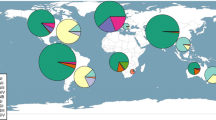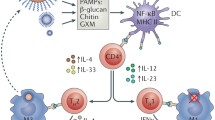Abstract
Over the previous decade, we observed the emergence of the fungal pathogen, Cryptococcus gattii, as a cause of disease in humans and animals in a temperate climate. This outbreak, first documented on Vancouver Island, has since expanded throughout Western North America, with non–travel-associated cases now in British Columbia, Washington, Oregon, and California. Additionally, a secondary outbreak, originating in and still restricted to Oregon, has also occurred. During the past several years, several studies detailing molecular typing, virulence, antifungal susceptibilities, epidemiology, and clinical issues have been published. These studies begin to address the complex dynamics of this novel emergence of a rare and fatal fungus, outline clinical characteristics of human cases, and also opened several new areas that should be explored in the upcoming years.

Similar content being viewed by others
References
Papers of particular interest, published recently, have been highlighted as: •Of importance •• Of major importance
Cohen ML. Changing patterns of infectious disease. Nature. 2000;406:762–7.
Morens DM, Folkers GK, Fauci AS. The challenge of emerging and re-emerging infectious diseases. Nature. 2004;430:242–9.
Morens DM, Folkers GK, Fauci AS. Emerging infections: a perpetual challenge. Lancet Infect Dis. 2008;8:710–9.
King DA, Peckham C, Waage JK, et al. Epidemiology. Infectious diseases: preparing for the future. Science. 2006;313:1392–3.
•• Galanis E, MacDougall L. Epidemiology of Cryptococcus gattii, British Columbia, Canada, 1999–2007. Emerg Infect Dis. 2010;16:251–7. This important study documents the epidemiological details of the C. gattii outbreak within British Columbia from the onset in 1999 through 2007. Interestingly, the authors found that although VGIIa predominates (>95% of cases), it does not seem to cause greater illness or death when compared to other strains. More and larger studies will be necessary to determine if clinical outcomes are different based on isolate types.
Fisher D, Burrow J, Lo D, Currie B. Cryptococcus neoformans in tropical northern Australia: predominantly variant gattii with good outcomes. Aust N Z J Med. 1993;23:678–82.
Seaton RA. The management of cryptococcal meningitis in Papua New Guinea. P N G Med J. 1996;39:67–73.
Kwon-Chung KJ. Morphogenesis of Filobasidiella neoformans, the sexual state of Cryptococcus neoformans. Mycologia. 1976;68:821–33.
Kwon-Chung KJ. A new species of Filobasidiella, the sexual state of Cryptococcus neoformans B and C serotypes. Mycologia. 1976;68:943–6.
Casadevall A, Perfect J. Cryptococcus neoformans. Washington: ASM; 1998.
Findley K, Rodriguez-Carres M, Metin B, et al. Phylogeny and phenotypic characterization of pathogenic Cryptococcus species and closely related saprobic taxa in the Tremellales. Eukaryot Cell. 2009;8:353–61.
Heitman J, Kozel T, Kwon-Chung J, et al. Cryptococcus: from human pathogen to model yeast. Washington: ASM; 2011.
Park BJ, Wannemuehler KA, Marston BJ, et al. Estimation of the current global burden of cryptococcal meningitis among persons living with HIV/AIDS. AIDS. 2009;23:525–30.
Kwon-Chung KJ, Varma A. Do major species concepts support one, two or more species within Cryptococcus neoformans? FEMS Yeast Res. 2006;6:574–87.
Boekhout T, Theelen B, Diaz M, et al. Hybrid genotypes in the pathogenic yeast Cryptococcus neoformans. Microbiology. 2001;147:891–907.
Kwon-Chung KJ, Polacheck I, Bennett JE. Improved diagnostic medium for separation of Cryptococcus neoformans var. neoformans (serotypes A and D) and Cryptococcus neoformans var. gattii (serotypes B and C). J Clin Microbiol. 1982;15:535–7.
Kidd SE, Guo H, Bartlett KH, et al. Comparative gene genealogies indicate that two clonal lineages of Cryptococcus gattii in British Columbia resemble strains from other geographical areas. Eukaryot Cell. 2005;4:1629–38.
Sorrell TC. Cryptococcus neoformans variety gattii. Med Mycol. 2001;39:155–68.
•• Byrnes 3rd EJ, Li W, Lewit Y, et al. Emergence and pathogenicity of highly virulent Cryptococcus gattii genotypes in the northwest United States. PLoS Pathog. 2010;6:e1000850. This study uses high-resolution molecular typing to illustrate a clear expansion of the C. gattii outbreak throughout Washington and Oregon. Additionally, virulence of the novel VGIIc genotype is characterized, showing high virulence (similar to VGIIa) in both macrophage and murine models of infection.
Fraser JA, Giles SS, Wenink EC, et al. Same-sex mating and the origin of the Vancouver Island Cryptococcus gattii outbreak. Nature. 2005;437:1360–4.
Kidd SE, Hagen F, Tscharke RL, et al. A rare genotype of Cryptococcus gattii caused the cryptococcosis outbreak on Vancouver Island (British Columbia, Canada). Proc Natl Acad Sci U S A. 2004;101:17258–63.
Castanon-Olivares LR, Lopez-Martinez R, Barriga-Angulo G, Rios-Rosas C. Crytococcus neoformans var. gattii in an AIDS patient: first observation in Mexico. J Med Vet Mycol. 1997;35:57–9.
Olivares LR, Martinez KM, Cruz RM, et al.: Genotyping of Mexican Cryptococcus neoformans and C. gattii isolates by PCR-fingerprinting. Med Mycol: (2009) 1-9.
Byrnes EJ, 3 rd, Li W, Ren P, et al.: A diverse population of Cryptococcus gattii molecular type VGIII in Southern Californian HIV/AIDS patients. PLoS Pathog Under Review (2011)
Chaturvedi S, Dyavaiah M, Larsen RA, Chaturvedi V. Cryptococcus gattii in AIDS patients, southern California. Emerg Infect Dis. 2005;11:1686–92.
Kidd SE, Chow Y, Mak S, et al. Characterization of environmental sources of the human and animal pathogen Cryptococcus gattii in British Columbia, Canada, and the Pacific Northwest of the United States. Appl Environ Microbiol. 2007;73:1433–43.
Byrnes 3rd EJ, Bildfell RJ, Dearing PL, et al. Cryptococcus gattii with bimorphic colony types in a dog in western Oregon: additional evidence for expansion of the Vancouver Island outbreak. J Vet Diagn Invest. 2009;21:133–6.
Byrnes 3rd EJ, Bildfell RJ, Frank SA, et al. Molecular evidence that the range of the Vancouver Island outbreak of Cryptococcus gattii infection has expanded into the Pacific Northwest in the United States. J Infect Dis. 2009;199:1081–6.
Duncan C, Bartlett KH, Lester S, et al.: Surveillance for Cryptococcus gattii in horses of Vancouver Island, British Columbia, Canada. Med Mycol In Press (2011)
Duncan C, Schwantje H, Stephen C, et al. Cryptococcus gattii in wildlife of Vancouver Island, British Columbia, Canada. J Wildl Dis. 2006;42:175–8.
Stephen C, Lester S, Black W, et al. Multispecies outbreak of cryptococcosis on southern Vancouver Island, British Columbia. Can Vet J. 2002;43:792–4.
Litvintseva AP, Thakur R, Vilgalys R, Mitchell TG. Multilocus sequence typing reveals three genetic subpopulations of Cryptococcus neoformans var. grubii (serotype A), including a unique population in Botswana. Genetics. 2006;172:2223–38.
MacDougall L, Kidd SE, Galanis E, et al. Spread of Cryptococcus gattii in British Columbia, Canada, and detection in the Pacific Northwest, USA. Emerg Infect Dis. 2007;13:42–50.
Meyer W, Aanensen DM, Boekhout T, et al. Consensus multi-locus sequence typing scheme for Cryptococcus neoformans and Cryptococcus gattii. Med Mycol. 2009;47:561–70.
Maiden MC, Bygraves JA, Feil E, et al. Multilocus sequence typing: a portable approach to the identification of clones within populations of pathogenic microorganisms. Proc Natl Acad Sci U S A. 1998;95:3140–5.
Upton A, Fraser JA, Kidd SE, et al. First contemporary case of human infection with Cryptococcus gattii in Puget Sound: evidence for spread of the Vancouver Island outbreak. J Clin Microbiol. 2007;45:3086–8.
Iqbal N, Debess EE, Wohrle R, et al. Correlation of genotype and in vitro susceptibilities of Cryptococcus gattii from the Pacific Northwest of the United States. J Clin Microbiol. 2009;48:539–44.
• Ma H, Hagen F, Stekel DJ, et al. The fatal fungal outbreak on Vancouver Island is characterized by enhanced intracellular parasitism driven by mitochondrial regulation. Proc Natl Acad Sci U S A. 2009;106:12980–5. In this study, Ma et al. show that the VGIIa genotype has a high proliferation rate inside macrophages. They also show that this phenotype correlated to both in vivo virulence and a tubular mitochondrial phenotype. Via microarray analysis, their findings suggest that the VGIIa mitochondrial genome might be implicated in virulence.
West SK, Byrnes EJ, 3 rd , Mostad S, et al.: Emergence of Cryptococcus gattii in the Pacific Northwest United States. Presented at the 48th Annual ICAAC/IDSA 46th Annual Meeting, Washington, DC, October 25–28, 2008 Oral presentation, Session 179 Abstract M-1849 Page 658 of the Abstract Book. (2008)
•• CDC: Emergence of Cryptococcus gattii—Pacific Northwest, 2004–2010. MMWR Morb Mortal Wkly Rep (2011) 59: 865–868. This report is the first comprehensive public health study of the C. gattii outbreak within the United States. In total, more than 50 human cases are documented. It is also shown that although the mortality rate in Canada is less than 9%, the mortality rate in the United States ranges from 20% to 33%.
• Macdougall L, Fyfe M, Romney M, et al. Risk Factors for Cryptococcus gattii Infection, British Columbia, Canada. Emerg Infect Dis. 2011;17:193–9. This study documents risk factors for C. gattii infection in people diagnosed in British Columbia, Canada. The authors found that receipt of oral corticosteroids, pneumonia, lung conditions, ≥50 years of age, smoking, HIV infection, and history of invasive cancer were all significant factors associated with infection. Although this infection has classically been reported to cause infection in otherwise healthy people, patients with infection in North America have had a multitude of underlying diagnoses.
Perfect JR, Dismukes WE, Dromer F, et al. Clinical practice guidelines for the management of cryptococcal disease: 2010 update by the Infectious Diseases Society of America. Clin Infect Dis. 2010;50:291–322.
Graybill JR, Sobel J, Saag M, et al. Diagnosis and management of increased intracranial pressure in patients with AIDS and cryptococcal meningitis. The NIAID Mycoses Study Group and AIDS Cooperative Treatment Groups. Clin Infect Dis. 2000;30:47–54.
Lane M, McBride J, Archer J. Steroid responsive late deterioration in Cryptococcus neoformans variety gattii meningitis. Neurology. 2004;63:713–4.
Phillips P, Chapman K, Sharp M, et al. Dexamethasone in Cryptococcus gattii central nervous system infection. Clin Infect Dis. 2009;49:591–5.
Hagen F, Illnait-Zaragozi MT, Bartlett KH, et al.: In vitro antifungal susceptibilities and AFLP genotyping of a worldwide collection of 350 clinical, veterinary and environmental Cryptococcus gattii isolates. Antimicrob Agents Chemother (2010).
• Datta K, Bartlett KH, Baer R, et al. Spread of Cryptococcus gattii into Pacific Northwest region of the United States. Emerg Infect Dis. 2009;15:1185–91. This paper highlighted and reviewed the emergence of the outbreak, overviewed previous findings, and recommended future goals. Importantly, this paper was a product of a multidisciplinary and international C. gattii working group of the Pacific Northwest.
Datta K, Bartlett KH, Marr KA: Cryptococcus gattii: Emergence in Western North America: Exploitation of a Novel Ecological Niche. Interdiscip Perspect Infect Dis 2009: 176532.
D’Souza CA, Kronstad JW, Taylor G, et al.: Genome variation in Cryptococcus gattii, an emerging pathogen of immunocompetent hosts. MBio (2011) 2.
Disclosure
Conflicts of interest: E.J. Byrnes III—none; K.A. Marr—consultancies, Astellas, Basilea, Merck, Pfizer, grants, Astellas and Merck.
Author information
Authors and Affiliations
Corresponding author
Rights and permissions
About this article
Cite this article
Byrnes, E.J., Marr, K.A. The Outbreak of Cryptococcus gattii in Western North America: Epidemiology and Clinical Issues. Curr Infect Dis Rep 13, 256–261 (2011). https://doi.org/10.1007/s11908-011-0181-0
Published:
Issue Date:
DOI: https://doi.org/10.1007/s11908-011-0181-0




